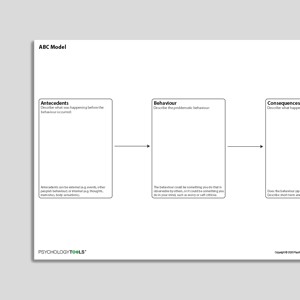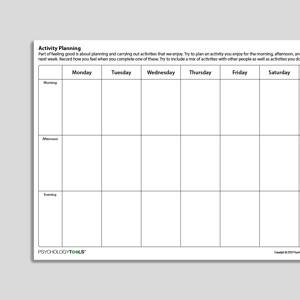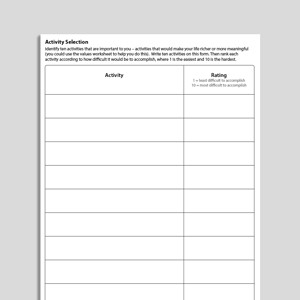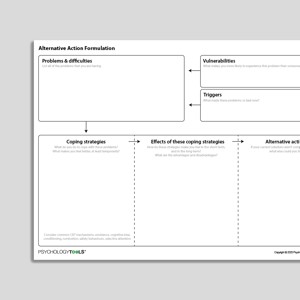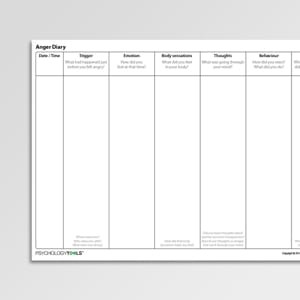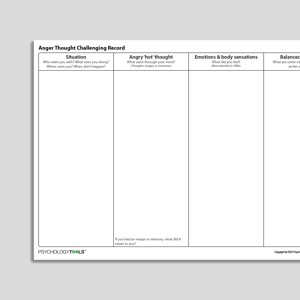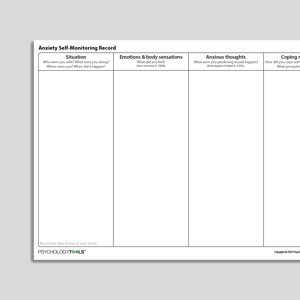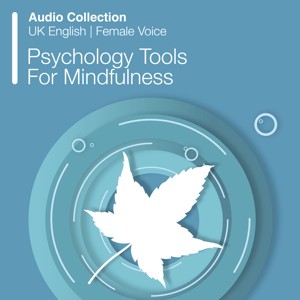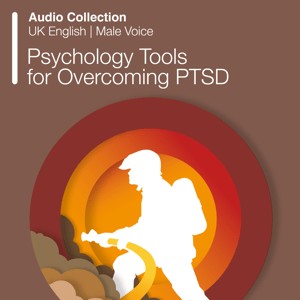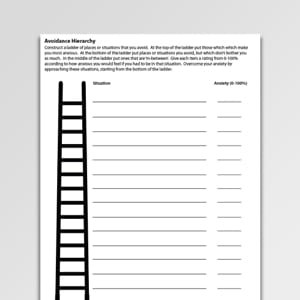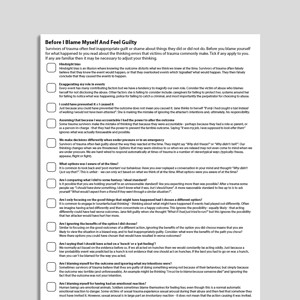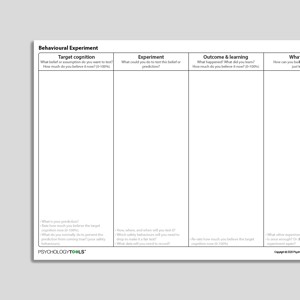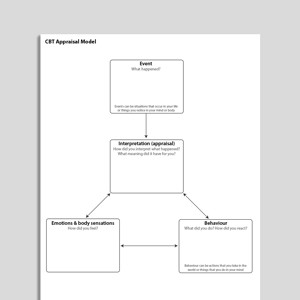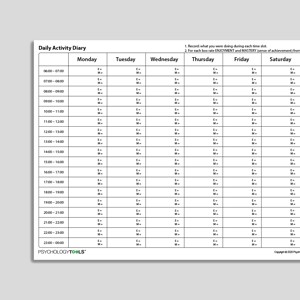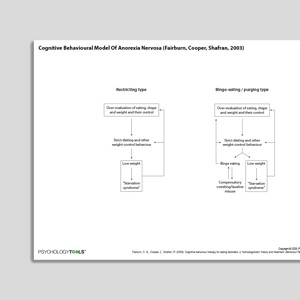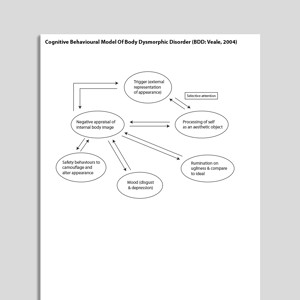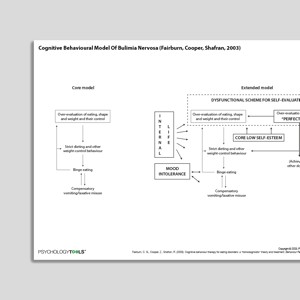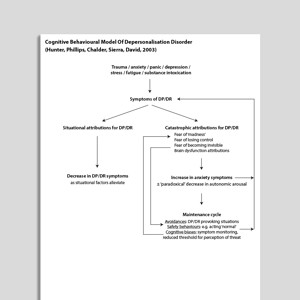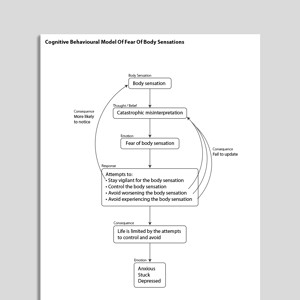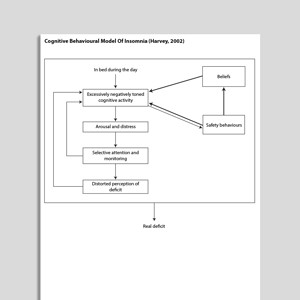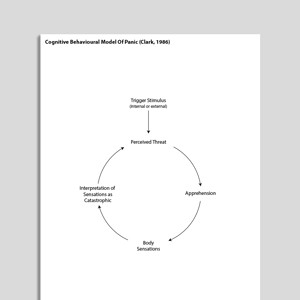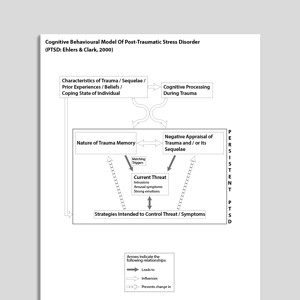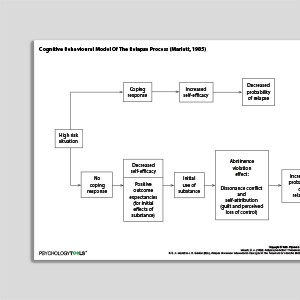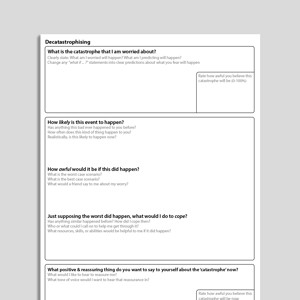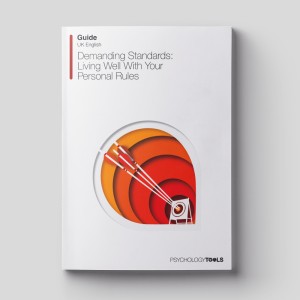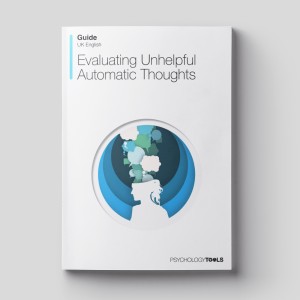Cognitive Behavioral Therapy (CBT)
Cognitive behavior therapy (CBT) is a popular form of psychological therapy that works with our thoughts, feelings, and behaviors. CBT is an integration of principles from behavior therapy with theory and methods from the cognitive therapies developed by Aaron Beck and Albert Ellis. The CBT that is practiced today has evolved with new developments in basic and applied research; it is grounded in empirical research and clinical practice. CBT is a broad church: the family of ‘cognitive and behavioral therapies’ encompasses many approaches including cognitive therapy, acceptance and commitment therapy (ACT), dialectical behavior therapy (DBT), and compassion-focused therapy (CFT).
Beck’s cognitive model identifies different levels of human cognitions: automatic thoughts are the most superficial level of cognition and describe the thoughts, words, ideas, and images that seem to pop into our minds; rigid and over-generalized core beliefs about ourselves, the world, and other people; and intermediate attitudes, rules, and assumptions that are influenced by our core beliefs. The cognitive model proposes that how we feel emotionally, and how we act, are determined by how we interpret and think about a situation. It argues that psychological problems and disorders are the result of dysfunctional thinking, and are maintained by self-defeating behavior influenced by inaccurate beliefs. Cognitive behavior therapists understand that by changing the way we think and act in the here-and-now we can change the way we feel, and CBT often begins with a focus on what is maintaining a problem in the present. For lasting change, CBT therapists often work with the deeper levels of their client’s beliefs and assumptions. Read more
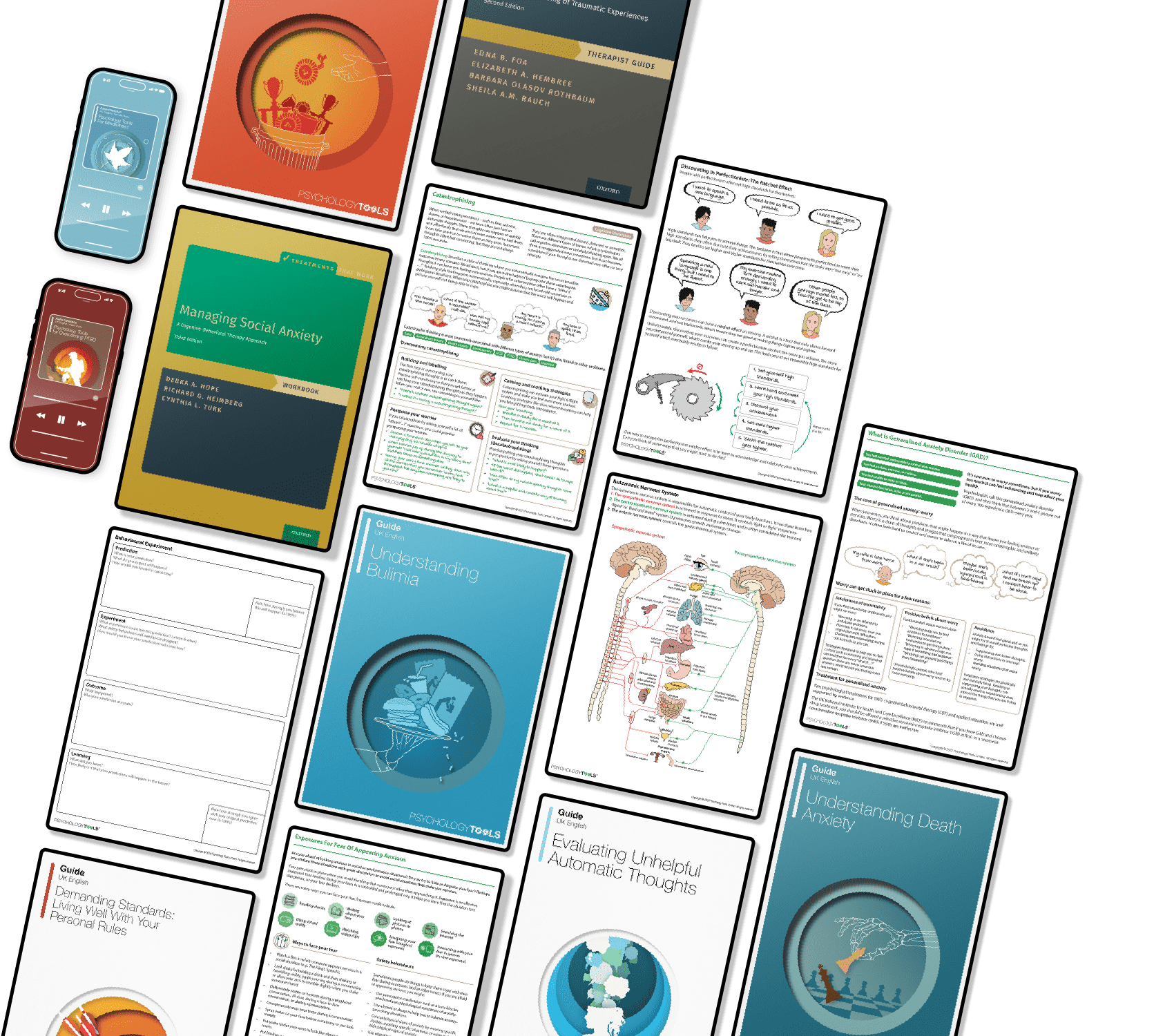
100 of 292 resources
"Should" Statements
“Should” statements (sometimes referred to as ‘musturbation’, ‘necessitous thinking’, ‘self-commands’, and ‘injunctions’) are char ...
https://www.psychologytools.com/resource/should-statements
ABC Model
ABC is an acronym for Antecedents, Behavior, Consequences. It is used as a tool for the assessment and formulation of problem behaviors and is useful ...
https://www.psychologytools.com/resource/abc-model
Activity Diary (Hourly Time Intervals)
Activity diaries can be used for activity monitoring during an assessment phase of therapy, symptom monitoring during therapy, correlating activity wi ...
https://www.psychologytools.com/resource/activity-diary-hourly-time-intervals
Activity Diary (No Time Intervals)
Activity diaries can be used for activity monitoring during an assessment phase of therapy, symptom monitoring during therapy, correlating activity wi ...
https://www.psychologytools.com/resource/activity-diary-no-time-intervals
Activity Menu
Helping clients to choose which activities to target during behavioral activation (BA) can be accomplished in a variety of ways: activity monitoring c ...
https://www.psychologytools.com/resource/activity-menu
Activity Planning
Research suggests that an activity is more likely to be completed if it is planned and scheduled in advance. The Activity Planning worksheet can be us ...
https://www.psychologytools.com/resource/activity-planning
Activity Selection
Activity selection is a technique for rating the difficulty of different activities. It is a helpful tool when clients have difficulty choosing betwee ...
https://www.psychologytools.com/resource/activity-selection
All-Or-Nothing Thinking
All-or-nothing thinking (often also referred to as ‘black and white thinking’, ‘dichotomous thinking’, ‘absolutist thinking’, or ‘binary ...
https://www.psychologytools.com/resource/all-or-nothing-thinking
Alternative Action Formulation
The Alternative Action Formulation is a CBT case conceptualization (formulation) worksheet. Formulations help a client and therapist come to a shared ...
https://www.psychologytools.com/resource/alternative-action-formulation
An Introduction To CBT (Psychology Tools For Living Well)
Cognitive behavioral therapy can help your clients to live happier and more fulfilling lives. Psychology Tools for Living Well is a self-help course ...
https://www.psychologytools.com/resource/an-introduction-to-cbt-psychology-tools-for-living-well
Anger - Self-Monitoring Record
Developing self-monitoring skills teaches clients to systematically observe and record specific targets such as their own thoughts, body feelings, emo ...
https://www.psychologytools.com/resource/anger-self-monitoring-record
Anger Decision Sheet
Individuals who have a problem with anger can benefit from considering and rehearsing different responses to triggering situations. The Anger Decision ...
https://www.psychologytools.com/resource/anger-decision-sheet
Anger Diary (Archived)
NOTE: An improved version of this resource is available here: Anger – Self-Monitoring Record. Older versions of a resource may be archived in t ...
https://www.psychologytools.com/resource/anger-diary-archived
Anger Self-Monitoring Record (Archived)
NOTE: An improved version of this resource is available here: Anger Self-Monitoring Record. Older versions of a resource may be archived in the event ...
https://www.psychologytools.com/resource/anger-self-monitoring-record-archived
Anger Thought Challenging Record
Evaluating and disputing thoughts is a fundamental skill taught by cognitive therapists to their clients. The Anger Thought Challenging Record can hel ...
https://www.psychologytools.com/resource/anger-thought-challenging-record
Anxiety - Self-Monitoring Record
Developing self-monitoring skills teaches clients to systematically observe and record specific targets such as their own thoughts, body feelings, emo ...
https://www.psychologytools.com/resource/anxiety-self-monitoring-record
Anxiety Self-Monitoring Record (Archived)
NOTE: An improved version of this resource is available here: Anxiety Self-Monitoring Record. Older versions of a resource may be archived in the even ...
https://www.psychologytools.com/resource/anxiety-self-monitoring-record-archived
Arbitrary Inference
Arbitrary inference is one of the earliest and broadest cognitive disotortions described in CBT. Beck defines it as "the process of forming an interpr ...
https://www.psychologytools.com/resource/arbitrary-inference
Assertive Communication
Communicating and acting assertively is an interpersonal skill that helps people to maintain healthy relationships, resolve interpersonal conflict, an ...
https://www.psychologytools.com/resource/assertive-communication
Assertive Responses
Being able to communicate assertively is an essential skill for developing and maintaining healthy relationships and positive self-esteem. Individuals ...
https://www.psychologytools.com/resource/assertive-responses
Attention - Self-Monitoring Record
Developing self-monitoring skills teaches clients to systematically observe and record specific targets such as their own thoughts, body feelings, emo ...
https://www.psychologytools.com/resource/attention-self-monitoring-record
Audio Collection: Psychology Tools For Mindfulness
The Psychology Tools For Mindfulness Audio Collection is the perfect way to introduce your clients to the practice of mindfulness. Developed by a clin ...
https://www.psychologytools.com/resource/psychology-tools-for-mindfulness-audio-collection
Audio Collection: Psychology Tools For Overcoming PTSD
The Psychology Tools for Overcoming PTSD Audio Collection is designed for anyone with post-traumatic stress disorder (PTSD). This skills development p ...
https://www.psychologytools.com/resource/psychology-tools-for-overcoming-ptsd-audio-collection
Autonomic Nervous System
The autonomic nervous system (ANS) automatically regulates the function of body systems outside of voluntary control. The Autonomic Nervous System han ...
https://www.psychologytools.com/resource/autonomic-nervous-system
Avoidance Hierarchy (Archived)
NOTE: An improved version of this resource is available here: Fear Ladder. Older versions of a resource may be archived in the event that they are ava ...
https://www.psychologytools.com/resource/avoidance-hierarchy
Before I Blame Myself And Feel Guilty
Guilt is a common post-traumatic reaction and is often the result of cognitive bias. This CBT worksheet explores common cognitive biases that have bee ...
https://www.psychologytools.com/resource/before-i-blame-myself-and-feel-guilty
Behavioral Activation Activity Diary
Behavioral activation (BA) is an effective treatment for depression. Different behavioral activation protocols include a variety of treatment componen ...
https://www.psychologytools.com/resource/behavioral-activation-activity-diary
Behavioral Activation Activity Planning Diary
Behavioral activation (BA) is an effective treatment for depression. Different behavioral activation protocols include a variety of treatment componen ...
https://www.psychologytools.com/resource/behavioral-activation-activity-planning-diary
Behavioral Experiment
Behavioral experiments are planned experiential activities to test the validity of a belief. They are one of the most powerful techniques available to ...
https://www.psychologytools.com/resource/behavioral-experiment
Behavioral Experiment (Portrait Format)
Behavioral experiments allow individuals to test the validity of their beliefs and assumptions. They are a core experiential technique for therapeutic ...
https://www.psychologytools.com/resource/behavioral-experiment-portrait-format
Belief Driven Formulation
Cognitive behavioral theory proposes that our thoughts, feelings, and behavior in the here-and-now are influenced by our schemas / core beliefs / assu ...
https://www.psychologytools.com/resource/belief-driven-formulation
Belief-O-Meter (CYP)
The Belief-O-Meter is an engaging way of helping children and adolescents to relate to their thoughts differently. It is a form of cognitive restructu ...
https://www.psychologytools.com/resource/belief-o-meter-cyp
Boundaries - Self-Monitoring Record
Developing self-monitoring skills teaches clients to systematically observe and record specific targets such as their own thoughts, body feelings, emo ...
https://www.psychologytools.com/resource/boundaries-self-monitoring-record
Catastrophizing
The Catastrophizing information handout forms part of the cognitive distortions series. It is designed to help clients and therapists to work more eff ...
https://www.psychologytools.com/resource/catastrophizing
Catching Your Thoughts (CYP)
Before thoughts can be examined or challenged they must be ‘caught’ – they must be noticed and distinguished from events and feelings. The Catch ...
https://www.psychologytools.com/resource/catching-your-thoughts-cyp
CBT Appraisal Model
The CBT Appraisal Model worksheet is a transdiagnostic formulation tool. The centrality of appraisals underpins all of the disorder-specific cognitive ...
https://www.psychologytools.com/resource/cbt-appraisal-model
CBT Daily Activity Diary With Enjoyment And Mastery Ratings
Activity diaries can be used for activity monitoring during an assessment phase of therapy, symptom monitoring during therapy, correlating activity wi ...
https://www.psychologytools.com/resource/cbt-daily-activity-diary-e-m
CBT Thought Record Portrait
The CBT Thought Record is an essential tool in cognitive behavioral therapy. Thought challenging records help people to evaluate their negative automa ...
https://www.psychologytools.com/resource/cbt-thought-record-portrait
Challenging Your Negative Thinking (Archived)
NOTE: An improved version of this resource is available here: Evaluating Unhelpful Automatic Thoughts. Older versions of a resource may be archived in ...
https://www.psychologytools.com/resource/challenging-your-negative-thinking
Changing Avoidance (Behavioral Activation)
Behavioral activation (BA) is a structured psychotherapeutic approach effective for a range of disorders, including depression (Ekers et al., 2014), a ...
https://www.psychologytools.com/resource/changing-avoidance-behavioral-activation
Checking Certainty And Doubt
Psychologists have discovered interesting relationships between Checking, Certainty, And Doubt. This information handout contains an exercise helpful ...
https://www.psychologytools.com/resource/checking-certainty-and-doubt
Classical Conditioning
Classical conditioning is a process by which stimuli become associated with responses. This information handout describes key principles of Classical ...
https://www.psychologytools.com/resource/classical-conditioning
Cognitive Behavioral Model Of Anorexia Nervosa (Fairburn, Cooper, Shafran, 2003)
Anorexia nervosa is an eating disorder characterized by restriction of energy intake and intense fear of gaining weight. For women, the lifetime preva ...
https://www.psychologytools.com/resource/cognitive-behavioral-model-of-anorexia-nervosa-fairburn-cooper-shafran-2003
Cognitive Behavioral Model Of Body Dysmorphic Disorder (BDD: Veale, 2004)
Individuals with body dysmorphic disorder (BDD) experience distress associated with their body image. The Cognitive Behavioral Model Of Body Dysmorphi ...
https://www.psychologytools.com/resource/cognitive-behavioral-model-of-body-dysmorphic-disorder-bdd-veale-2004
Cognitive Behavioral Model Of Bulimia Nervosa (Fairburn, Cooper, Shafran, 2003)
Bulimia nervosa is an eating disorder characterized by binge eating followed by purging. Among young women, the point prevalence of bulimia is about 1 ...
https://www.psychologytools.com/resource/cognitive-behavioral-model-of-bulimia-nervosa-fairburn-cooper-shafran-2003
Cognitive Behavioral Model Of Clinical Perfectionism (Shafran, Cooper, Fairburn, 2002)
People with perfectionism pursue high standards in one or more areas of their life and base their self-worth on their ability to achieve these standar ...
https://www.psychologytools.com/resource/cognitive-behavioral-model-of-clinical-perfectionism-shafran-cooper-fairburn-2002
Cognitive Behavioral Model Of Depersonalization (Hunter, Phillips, Chalder, Sierra, David, 2003)
Depersonalization is an experience where an individual feels a sense of detachment from themselves, or estrangement from their perceptions, actions, a ...
https://www.psychologytools.com/resource/cognitive-behavioral-model-of-depersonalization-hunter-phillips-chalder-sierra-david-2003
Cognitive Behavioral Model Of Fear Of Body Sensations
Fear of bodily sensations is present in a number of conditions, most notably panic disorder. The Cognitive Behavioral Model Of Fear Of Bodily Sensatio ...
https://www.psychologytools.com/resource/cognitive-behavioral-model-of-fear-of-body-sensations
Cognitive Behavioral Model Of Generalized Anxiety Disorder (GAD: Dugas, Gagnon, Ladouceur, Freeston, 1998)
Individuals with generalized anxiety disorder (GAD) report significant worry which they find difficult to control and experience as distressing. Numer ...
https://www.psychologytools.com/resource/cognitive-behavioral-model-of-generalized-anxiety-disorder-gad-dugas-gagnon-ladouceur-freeston-1998
Cognitive Behavioral Model Of Health Anxiety (Salkovskis, Warwick, Deale, 2003)
Health anxiety is characterized by a preoccupation with having or acquiring a serious illness, and a high level of anxiety about health. People with h ...
https://www.psychologytools.com/resource/cognitive-behavioral-model-of-health-anxiety-salkovskis-warwick-deale-2003
Cognitive Behavioral Model Of Insomnia (Harvey, 2002)
Insomnia is a highly prevalent sleep disorder characterized by difficulty initiating or maintaining sleep, or having non-restorative sleep for at leas ...
https://www.psychologytools.com/resource/cognitive-behavioral-model-of-insomnia-harvey-2002
Cognitive Behavioral Model Of Intolerance Of Uncertainty And Generalized Anxiety Disorder Symptoms (Hebert, Dugas, 2019)
Intolerance of uncertainty (IU) has been defined as “an underlying fear of the unknown”. Intolerance of uncertainty is a risk factor for the deve ...
https://www.psychologytools.com/resource/cognitive-behavioral-model-of-intolerance-of-uncertainty-and-generalized-anxiety-disorder-symptoms-hebert-dugas-2019
Cognitive Behavioral Model Of Panic (Clark, 1986)
The Cognitive Behavioral Model Of Panic identifies catastrophic misinterpretation of body sensations as a criticial maintenance factor which serves to ...
https://www.psychologytools.com/resource/cognitive-behavioral-model-of-panic-clark-1986
Cognitive Behavioral Model Of Persistent Postural-Perceptual Dizziness (PPPD: Whalley, Cane, 2017)
Persistent postural-perceptual dizziness (PPPD) is a form of dizziness which is thought to be maintained by psychological factors. This is a Cognitive ...
https://www.psychologytools.com/resource/cognitive-behavioral-model-of-persistent-postural-perceptual-dizziness-pppd-whalley-cane-2017
Cognitive Behavioral Model Of Post Traumatic Stress Disorder (PTSD: Ehlers & Clark, 2000)
Anke Ehlers' & David Clark's Cognitive Behavioral Model Of Post-Traumatic Stress Disorder (PTSD) is an influential account of the condition. The ...
https://www.psychologytools.com/resource/cognitive-behavioral-model-of-post-traumatic-stress-disorder-ptsd-ehlers-clark-2000
Cognitive Behavioral Model Of Social Phobia (Clark, Wells, 1995)
People suffering from social anxiety disorder (previously known as social phobia) experience persistent fear or anxiety concerning social or performan ...
https://www.psychologytools.com/resource/cognitive-behavioral-model-of-social-phobia-clark-wells-1995
Cognitive Behavioral Model Of The Relapse Process (Marlatt & Gordon, 1985)
Marlatt & Gordon’s cognitive behavioral model of relapse (1985) conceptualizes relapse as a “transitional process, a series of events that unf ...
https://www.psychologytools.com/resource/cognitive-behavioural-model-of-the-relapse-process-marlatt-gordon-1985
Cognitive Behavioral Model Of Tinnitus (McKenna, Handscombe, Hoare, Hall, 2014)
The Cognitive Behavioral Model Of Tinnitus identifies cognitive, behavioral, and perceptual changes which operate to maintain tinnitus perception and ...
https://www.psychologytools.com/resource/cognitive-behavioral-model-of-tinnitus-mckenna-handscombe-hoare-hall-2014
Cognitive Behavioral Treatment Of Childhood OCD: It's Only A False Alarm: Therapist Guide
Cognitive Behavioral Treatment Of Childhood OCD: It’s Only A False Alarm comes in two volumes. This page is for the Therapist Guide. Click on the fo ...
https://www.psychologytools.com/resource/cognitive-behavioral-treatment-of-childhood-ocd-its-only-a-false-alarm-therapist-guide
Cognitive Behavioral Treatment of Childhood OCD: It's Only a False Alarm: Workbook
Cognitive Behavioral Treatment Of Childhood OCD: It’s Only A False Alarm comes in two volumes. This page is for the Workbook. Click on the following ...
https://www.psychologytools.com/resource/cognitive-behavioral-treatment-of-childhood-ocd-its-only-a-false-alarm-workbook
Cognitive Case Formulation
The Cognitive Case Formulation is a CBT case conceptualization tool that aims to help therapists derive core and intermediate beliefs from an analysis ...
https://www.psychologytools.com/resource/cognitive-case-formulation
Cognitive Distortions – Unhelpful Thinking Styles (Common)
Cognitive distortions (or ‘unhelpful thinking styles’) are ways that our thoughts become biased. Different cognitive biases are associated with di ...
https://www.psychologytools.com/resource/cognitive-distortions-unhelpful-thinking-styles-common
Cognitive Distortions – Unhelpful Thinking Styles (Extended)
Cognitive distortions (or ‘unhelpful thinking styles’) are ways that our thoughts become biased. Different cognitive biases are associated with di ...
https://www.psychologytools.com/resource/cognitive-distortions-unhelpful-thinking-styles-extended
Compassionate Thought Challenging Record
Thought challenging records are commonly used in CBT to help people to evaluate their negative automatic thoughts for accuracy and bias. This Compassi ...
https://www.psychologytools.com/resource/compassionate-thought-challenging-record
Core Belief Magnet Metaphor
Core beliefs (schemas) are self-sustaining. They act to 'attract' confirmatory evidence and 'repel' (or distort) disconfirmatory evidence. This inform ...
https://www.psychologytools.com/resource/core-belief-magnet-metaphor
Court Trial Thought Challenging Record (Archived)
NOTE: An improved version of this resource is available here: Thought Record - Courtroom Trial. Older versions of a resource may be archived in the ev ...
https://www.psychologytools.com/resource/court-trial-thought-challenging-record
Critical Care And PTSD
The Critical Care And PTSD information handout is designed to help clients to learn about the properties of critical care that can increase the likeli ...
https://www.psychologytools.com/resource/critical-care-and-ptsd
Critical Illness Intensive Care And Post-Traumatic Stress Disorder (PTSD)
This is a free guide designed for people who have spent time in an intensive care unit and are experiencing symptoms of post-traumatic stress disorder ...
https://www.psychologytools.com/resource/critical-illness-intensive-care-and-post-traumatic-stress-disorder-ptsd
Cross Sectional Formulation
Case conceptualizations (formulations) help therapists and clients come to a shared understanding of a problem. This Cross Sectional Formulation explo ...
https://www.psychologytools.com/resource/cross-sectional-formulation
Daily Monitoring Form
Activity diaries can be used for activity monitoring during an assessment phase of therapy, symptom monitoring during therapy, correlating activity wi ...
https://www.psychologytools.com/resource/daily-monitoring-form
Decatastrophizing
Catastrophic thinking (magnification) is characteristic of many anxiety problems. This CBT worksheet for decatastrophizing is a tool for cognitive res ...
https://www.psychologytools.com/resource/decatastrophizing
Demanding Standards – Living Well With Your Personal Rules
Demanding Standards – Living Well With Your Personal Rules is a guide written for clients who have high or perfectionistic standards which cause th ...
https://www.psychologytools.com/resource/demanding-standards-living-well-with-your-personal-rules
Depression - Self-Monitoring Record
Developing self-monitoring skills teaches clients to systematically observe and record specific targets such as their own thoughts, body feelings, emo ...
https://www.psychologytools.com/resource/depression-self-monitoring-record
Discounting In Perfectionism – The Ratchet Effect
When individuals with perfectionism successfully meet their demanding standards, these accomplishments are often discounted as “easy to do,” “no ...
https://www.psychologytools.com/resource/discounting-in-perfectionism-the-ratchet-effect
Disqualifying Others
This Disqualifying Others information handout forms part of the cognitive distortions series, designed to help clients and therapists to work more eff ...
https://www.psychologytools.com/resource/disqualifying-others
Disqualifying The Positive
This Disqualifying the Positive information handout forms part of the cognitive distortions series, designed to help clients and therapists work more ...
https://www.psychologytools.com/resource/disqualifying-the-positive
Dissociation - Self-Monitoring Record
Developing self-monitoring skills teaches clients to systematically observe and record specific targets such as their own thoughts, body feelings, emo ...
https://www.psychologytools.com/resource/dissociation-self-monitoring-record
Embracing Uncertainty
Intolerance of uncertainty (IU) was first described in individuals suffering from Generalized Anxiety Disorder (GAD). Many behaviors associated with G ...
https://www.psychologytools.com/resource/embracing-uncertainty
Emotional Reasoning
The Emotional Reasoning information handout forms part of the cognitive distortions series, designed to help clients and therapists to work more effec ...
https://www.psychologytools.com/resource/emotional-reasoning
Evaluating Unhelpful Automatic Thoughts
The Evaluating Unhelpful Automatic Thoughts guide is written for clients who struggle with negative automatic thoughts. It provides a comprehensive in ...
https://www.psychologytools.com/resource/evaluating-unhelpful-automatic-thoughts
Evaluating Your Demanding Standards
Striving to meet demanding standards can be a rewarding process and lead to significant gains. However, demanding standards can also have adverse cons ...
https://www.psychologytools.com/resource/evaluating-your-demanding-standards
Examining Your Negative Thoughts
Cognitive restructuring is an evidence-based intervention that involves identifying, evaluating, and modifying maladaptive cognitions, including negat ...
https://www.psychologytools.com/resource/examining-your-negative-thoughts
Exploring Problems Using A Cross Sectional Model
A cross-sectional formulation takes a ‘snapshot’ of what is going on during a single moment in time. The Exploring Problems Using A Cross-Sectiona ...
https://www.psychologytools.com/resource/exploring-problems-using-a-cross-sectional-model
Exposure And Response (Ritual) Prevention For Obsessive Compulsive Disorder (Second Edition): Therapist Guide
Exposure and Response (Ritual) Prevention for Obsessive-Compulsive Disorder comes in two volumes. This page is for the Therapist Guide. Click on the f ...
https://www.psychologytools.com/resource/exposure-and-response-ritual-prevention-for-obsessive-compulsive-disorder-therapist-guide
Exposure And Response Prevention
Exposure And Response Prevention (ERP, EX/RP) is an effective treatment for obsessive compulsive disorder (OCD). This CBT worksheet guides therapists ...
https://www.psychologytools.com/resource/exposure-and-response-prevention
Exposure Practice Form
Exposure is an effective treatment for many forms of anxiety. The Exposure Practice Form is a CBT worksheet which guides therapists and clients throug ...
https://www.psychologytools.com/resource/exposure-practice-form
Exposure Session Record
The Exposure Session Record is a tool for recording clients’ use of exposure. The worksheet guides clients to identify a specific fear they are will ...
https://www.psychologytools.com/resource/exposure-session-record
Exposures For Fear Of Appearing Anxious
Concerns about appearing anxious in front of others plays a central role in social anxiety. Exposure is an effective treatment for tackling these fear ...
https://www.psychologytools.com/resource/exposures-for-fear-of-appearing-anxious
Exposures For Fear Of Body Sensations
Fearful responses to physical sensations are common in several disorders. Interoceptive exposure (or ‘symptom induction’) is an effective treatmen ...
https://www.psychologytools.com/resource/exposures-for-fear-of-body-sensations
Exposures For Fear Of Breathlessness
Fearful responses to benign physical sensations such as breathlessness are common in several disorders, most notably panic disorder (with and without ...
https://www.psychologytools.com/resource/exposures-for-fear-of-breathlessness
Exposures For Fear Of Death
Fear of death is common, and is associated with a variety of psychological disorders including generalized anxiety disorder, depression, panic disorde ...
https://www.psychologytools.com/resource/exposures-for-fear-of-death
Exposures For Fear Of Flying
Fear of flying is a very common fear, affecting up to 18% of individuals, and is characterized by intense and persistent fear during, or in anticipati ...
https://www.psychologytools.com/resource/exposures-for-fear-of-flying
Exposures For Fear Of Heights
Fear of heights is a very common fear, characterized by an avoidance of high places including staircases, tall buildings, and bridges. Exposure is an ...
https://www.psychologytools.com/resource/exposures-for-fear-of-heights
Exposures For Fear Of Illness
Fear of illness is a common and persistent fear that can result in significant functional impairment. Exposure is an effective treatment for health-re ...
https://www.psychologytools.com/resource/exposures-for-fear-of-illness
Exposures For Fear Of Losing Control Of Your Mind
Fearful responses to benign physical sensations are common in several disorders, and interoceptive exposure (or ‘symptom induction’) is an effecti ...
https://www.psychologytools.com/resource/exposures-for-fear-of-losing-control-of-your-mind
Exposures For Fear Of Uncertainty
Fear of uncertainty is commonly associated with many psychological difficulties, including generalized anxiety disorder (GAD), obsessive compulsive di ...
https://www.psychologytools.com/resource/exposures-for-fear-of-uncertainty
Exposures For Fear Of Vomiting
Fear of vomiting is a chronic and distressing difficulty that is associated with significant impairment. Exposure is an effective treatment for addres ...
https://www.psychologytools.com/resource/exposures-for-fear-of-vomiting
Externalizing
The Externalizing information handout forms part of the cognitive distortions series, designed to help clients and therapists to work more effectively ...
https://www.psychologytools.com/resource/externalizing
Facing Your Fears (CYP)
Graded or graduated exposure is a traditional way of overcoming fears and phobias. The therapist helps the client to draw up a list of feared situatio ...
https://www.psychologytools.com/resource/facing-your-fears-cyp
Facing Your Fears And Phobias
The Facing Your Fears And Phobias guide is written for clients who struggle with fears or phobias. It provides comprehensive information about what fe ...
https://www.psychologytools.com/resource/facing-your-fears-and-phobias
Links to external resources
Psychology Tools makes every effort to check external links and review their content. However, we are not responsible for the quality or content of external links and cannot guarantee that these links will work all of the time.
Assessment
-
Supervisor Competency Scale (SCS)
| Kennerley, Clohessy, Butler, Muse, Rakovshik | 2014
- Scale
- Bern Inventory of Treatment Goals | Grosse, Grawe | 2002
Cognitive therapy competence / adherence measures
-
Revised Cognitive Therapy Scale (CTS-R) – James, Blackburn, Reichelt Scale Manual
- Manual
- Scale
-
Cognitive Therapy Rating Scale (CTRS)
| Young, Beck | 1980
- Scale
- Manual
-
Assessment of Core CBT Skills (ACCS)
| Muse, McManus, Rakovshik, Kennerley
- Manual accs-scale.co.uk
- Feedback form accs-scale.co.uk
- Website accs-scale.co.uk
Case Conceptualization / Case Formulation
- Cognitive conceptualisation (excerpt from Basics and Beyond) | J. Beck
- Dysfunctional assumptions ideas
- Developing a cognitive formulation | Michael Free
- Case formulation in CBT | Caleb Lack
- A case formulation approach to cognitive-behavior therapy | Jacqueline Persons | 2015
- The case formulation approach to cognitive behavior therapy | Jacqueline Persons | 2014
Information (Professional)
- Cognitive- behavioural therapy An information guide | Neil Rector | 2010
- A therapist’s guide to brief cognitive behavioral therapy | Cully, Teten | 2008
- Problem solving (OCT Practical Guides | Helen Kennerley | 2016
- Working with Schemas, Core Beliefs, and Assumptions | Frank Wills | 2008
Presentations
- The role of a case conceptualization model and core tasks of intervention | Donald Miechenbaum | 2014
- Transdiagnostic treatments for anxiety disorders | Martin Anthony | 2013
- The unified protocol for the transdiagnostic treatment of emotional disorders | Ellen Frank, Fiona Ritchey | 2015
- Making CBT Work (Working with your CBT therapist / Making your CBT therapist work with you) | Paul Salkovskis
Treatment Guide
- A manual of cognitive behavior therapy for people with learning disabilities and common mental disorders | Hassiotis, Serfaty, Azam, Martin, Strydom, King | 2012
Video
- CBT case formulation | Jacqueline Persons
Recommended Reading
- Hofmann, S. G., Asnaani, A., Vonk, I. J., Sawyer, A. T., & Fang, A. (2012). The efficacy of cognitive behavioral therapy: a review of meta-analyses. Cognitive therapy and research, 36(5), 427-440
- Schema change processes in cognitive therapy | Padesky | 1994
- Wright, B., Williams, C., & Garland, A. (2002). Using the Five Areas cognitive–behavioural therapy model with psychiatric patients. Advances in Psychiatric Treatment, 8(4), 307-315.
- Williams, C., & Garland, A. (2002). Identifying and challenging unhelpful thinking. Advances in Psychiatric Treatment, 8(5), 377-386.
- Garland, A., Fox, R., & Williams, C. (2002). Overcoming reduced activity and avoidance: a Five Areas approach. Advances in Psychiatric Treatment, 8(6), 453-462.
- Williams, C., & Garland, A. (2002). A cognitive–behavioural therapy assessment model for use in everyday clinical practice. Advances in Psychiatric Treatment, 8(3), 172-179.
- A provider’s guide to brief cognitive behavioral therapy | Cully, Dawson, Hamer, Tharp | 2021
- Padesky, C. A., Mooney, K. A. (1990). Clinical tip: presenting the cognitive model to clients. International Cognitive Therapy Newsletter, 6, 13-14
- Arch, J. J., & Craske, M. G. (2009). First-line treatment: a critical appraisal of cognitive behavioral therapy developments and alternatives. Psychiatric Clinics of North America, 32(3), 525-547
What Is Cognitive Behavioral Therapy?
Assumptions of CBT
- people actively process information;
- our appraisals (the way that we think and interpret events) determine how we feel;
- dysfunctional thinking and biases in information processing (cognition/thinking) are responsible for the problems that people experience;
- different problems are associated with different cognitive themes (cognitive specificity theory): depression is associated with loss and defeat; anxiety is associated with danger and threat; obsessive-compulsive disorder is associated with inflated responsibility; substance abuse is associated with permissive beliefs; eating disorders are associated with self-criticism; social anxiety is associated with fear of evaluation; and PTSD is associated with appraisals of immediate threat;
- the thoughts that we have can be ‘distorted’ or biased. Common biases include over-generalization, arbitrary inference, selective abstraction, and catastrophizing;
- changing how we think and act will impact how we feel: cognition, emotion, and behavior interact in a reciprocal manner;
- psychopathology is a result of an interaction between stress and vulnerability;
- cognition happens at multiple levels (Alford & Beck, 1997) and all can influence the way that we feel and behave: preconscious, unintentional, automatic (e.g., negative automatic thoughts); the conscious level (e.g., if a patient is asked to explain the meaning of an automatic thought); and the metacognitive level (beliefs about beliefs);
- experiences, memories, thoughts, attitudes, and beliefs are encapsulated as ‘schemas’ and which may become activated and influence our perceptions and behaviors.
Principles of CBT
Judith Beck (1995) identified 11 principles of the practice of cognitive behavioral therapy, and these were expanded by Wills (2009):
- cognitive behavioral therapists use formulation to focus their therapeutic work
- cognitive behavioral therapists use formulation to tackle interpersonal and alliance issues
- cognitive behavioral therapy requires a sound therapeutic relationship
- cognitive behavioral therapists stress the importance of collaboration in the therapeutic relationship
- cognitive behavioral therapy is brief and time-limited
- cognitive behavioral therapy is structured and directional
- cognitive behavioral therapy is problem- and goal-oriented
- cognitive behavioral therapy initially emphasizes a focus on the present
- cognitive behavioral therapy uses an educational model
- homework and self-practice is a central feature of cognitive behavioral therapy (incorporating the use of CBT worksheets)
- cognitive behavioral therapists teach clients to evaluate and modify their thoughts
- cognitive behavioral therapy uses various methods to change cognitive content including thought records, behavioral experiments, surveys
- cognitive behavior therapy uses a variety of methods to promote behavioral change including exposure, behavioral experiments, role-play.
Procedures and Techniques of CBT
- Data gathering and symptom monitoring are used to understand problems and to measure change. CBT is an evidence-based approach that relies upon accurate data gathering regarding symptoms and experiences.
- Behavioral activation is a set of techniques for encouraging engagement in meaningful activity and is an effective treatment for depression.
- Case formulation is a method for understanding the origin and maintenance of a problem in cognitive and behavioral terms. CBT therapists may use a mixture of cross-sectional formulation to understand difficulties in the here-and-now, longitudinal formulation to understand the origins and precipitants of a problem, and cognitive behavioral models to understand the mechanisms underlying a problem.
- Cognitive restructuring describes techniques for changing what we think. It often involves the use of thought records, behavioral experiments, data gathering, or psychoeducation.
- Exposure is a technique from behavior therapy that is extensively used by CBT therapists, particularly for the treatment of anxiety. ‘Facing your fears’ is an essential behavioral component of CBT.
- Problem solving describes a series of techniques that are often taught as part of a CBT intervention. Effective problem solving helps people to make adaptive choices.
- Socratic methods are used by CBT therapists to help their clients explore what they know, and to form their own opinions on a topic. Aaron Beck encouraged the use of Socratic-like technique in his original treatment manual “use questioning rather than disputation and indoctrination … it is important to try to elicit from the patient what he is thinking rather than telling the patient what the therapist believes he is thinking” (Beck et al, 1979).
References
- Alford, B. A., & Beck, A. T. (1997). The relation of psychotherapy integration to the established systems of psychotherapy. Journal of psychotherapy integration, 7(4), 275-289.
- Beck, A. T., Rush, A. J., Shaw, B. F., & Emery, G. (1979). Cognitive therapy of depression. New York: Guilford.
- Beck, J. S. (1995). Cognitive therapy: Basics and beyond. New York: Guilford.
- Wills, F. (2009). Beck’s cognitive therapy. CBT Distinctive Features Series. New York: Routledge.

